Gayla Industries
by Ralph Dewey
One of the companies that makes #260 pencil balloons is Gayla Industries headquartered in Houston, Texas. I got a chance to tour their facilities recently. Their facility looked to be about 150,000 sq. ft. and filled with a variety of automated equipment for manufacturing, packaging, imprinting, sorting and shipping their products. I noticed paraphernalia and items relating to kites, stress balls, Mylar balloon and latex balloon all over the place. Les Phillips bought Gayla Industries in 1961 when they only made kites. In 1983 he saw a chance to expand their product line, so he added balloon manufacturing. Besides round latex balloons, Gayla Industries also make #260, #160 and #365 balloons. They also make punch balls too. Today Doug Phillips is the president, Cynthia Phillips is the corporate secretary and John Mirch is the VP of sales & marketing. Today at Gayla Industries balloons sales make up about 50% of their revenue. They produce approximately 600,000 balloons per day.
Making Balloons
The balloon making process is highly automated and laid out in a square pattern. Since balloons are a dipped product, the balloon formers (molds) are attached to moving racks which are attached to the frame of the machinery so they can hang down. Every part of the square has hundreds of balloon formers hanging in place. In the photos below there are round balloon formers and formers used for #260 balloons.
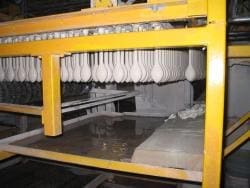
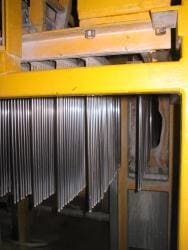
During the process of making balloons all of the formers travel completely around the square. The process starts at one corner with the formers being immersed in a water wash bath. This helps to remove any latex that didn’t release from the formers. Next in the line, the formers get dipped into a liquid coagulant bath. The coagulant causes the liquid latex to adhere to the formers.
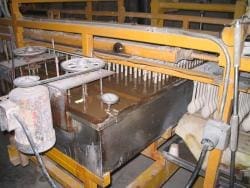
Next the formers get dipped into a vat of liquid latex which Gayla imports from Malaysia. The day I was touring they were making white 11″ round balloons. A white balloon on a white former didn’t show up in my photos very well. But, maybe on my next visit I’ll luck out and they’ll be making red or blue or orange. The former now travels through a short heating tunnel to give the latex a slight amount of curing. The curing process changes the latex from a sticky liquid into a stretchy solid. The next part of the process has the formers traveling single file threw the Bead Roller. The Bed Roller consists of some rotating brushes that roll the top of the latex down slightly to form the nozzle or lip of the balloon. The small amount of curing that the balloons now have gives the balloons the right consistency for this operation. Too little curing causes the brushes to tear up the latex. Too much curing causes the rolled lip not to stick and therefore unroll. A poorly formed nozzle would be the result. After the nozzle is fashioned on the balloon, the formers travel through a longer heating tunnel to complete the curing process. With that done, it’s time to remove the balloons. A spray made up of water with some talcum powder is aimed down toward the nozzles. Some of the water goes into the balloon and helps dislodge it from the former. The water also serves as a lubricant. The final event in the process is the stripper. Gayla uses two padded panels. They grab the balloons from two sides and pull them downward.
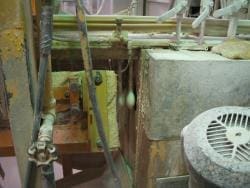
The wet balloons get stripped off of their formers and fall into what I thought looked like a laundry basket. Because the balloons need to be dried, they get placed into a commercial dryer and tumbled dried. By the way, some white towels are thrown in with the balloons to help soak up the water and to also shine the outside of the balloons. At this point in the process, the formers have completed the square and are back at the starting position. And the balloon manufacturing process gets started all over again.
Here is something I didn’t know. Gayla makes their own balloon colors by mixing their own pigments into the latex. Solid colors have to be made in “runs” of a single color. Balloons that go into an assorted bag of balloons all come from different color runs.
Once the balloon making process has been completed the balloons are weighed and placed into plastic bags. Now the balloons are ready for sale.
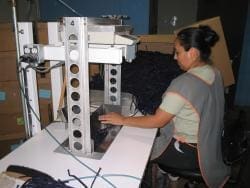
Gayla also imprints round balloons. They can put any type of graphics or text on the balloons.
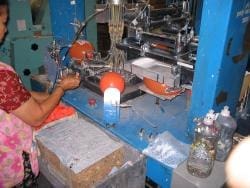
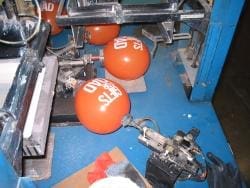
Gayla also makes punch balls. Here is a former for one of them.
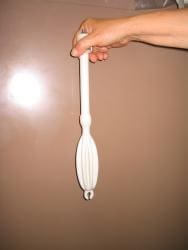
So the next time you twist a dog, giraffe or other animal out of a Gayla balloon you will know what it took to produce that skinny little tube of tree sap.